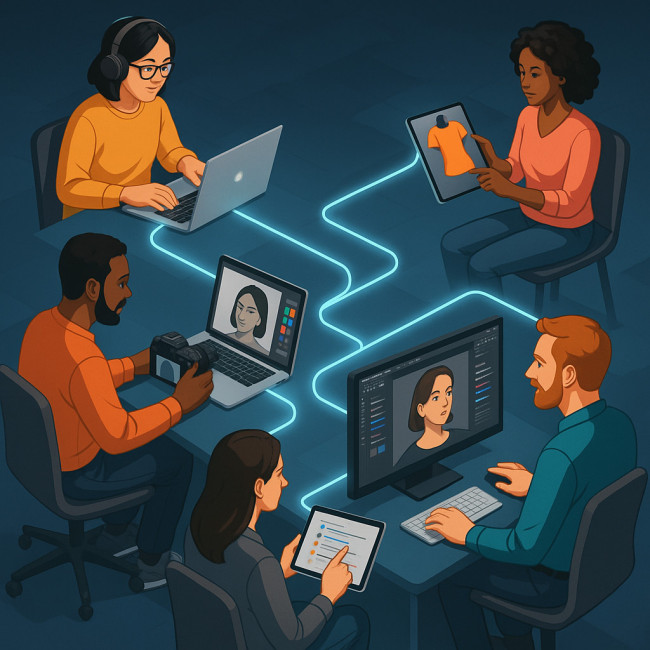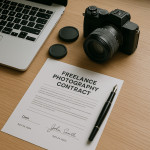Building cross-disciplinary photo teams: workflows for smooth remote shoots
Remote productions no longer mean one photographer juggling every task. Discover how to assemble a cross-disciplinary dream team, map bullet-proof workflows and use smart tools to deliver on-brief images without ever sharing a physical set.
Why cross-disciplinary teams win remote briefs

Clients are asking for bigger visual stories, tighter turnarounds and eco-friendlier logistics. When you combine specialists—photographer, digital tech, stylist, retoucher, producer—each professional focuses on their zone of genius, cutting wasted time and revisions by up to 40 % according to several commercial production reports.
- Broader skill pool = more creative options on the call sheet.
- Parallel workflows slash shooting days and travel emissions.
- Specialists speak directly to their opposite numbers in the brand team, reducing miscommunication.
Roles to recruit and how they interact
| Role | Main Deliverable | Critical Touchpoints | Time-Zone Flexibility |
|---|---|---|---|
| Lead Photographer | Creative direction & final RAWs | Kick-off brief, live capture, hand-off | High |
| Digital Tech | Tethered feed & color accuracy | Test shoot, live feedback, backup | Medium |
| Remote Stylist | Look boards & garment logistics | Pre-prod alignment, live approvals | High |
| Retoucher | Final layered PSDs | Reference pass, first draft, finals | Very high |
| Producer | Budget & schedule gatekeeper | All stages | Medium |
Need extra hands on shooting day? Review clear duty lists in the assistant role checklist so every junior hire knows exactly where to stand—onsite or on Zoom.
Workflow timeline for a flawless remote shoot
1. Pre-production (D-21 to D-1)
- Creative sync: walk through reference decks via a shared whiteboard. Speed alignment using collaborative mood-board tools.
- Scout & permits: the local producer captures 360° videos for client approval.
- Tech rehearsal: all crew log into the capture session, testing latency and chat protocols.
- Legal & payment: sign service and usage agreements. Consider retainer models for multi-phase campaigns.
2. Shoot day (D-0)
- Virtual call sheet dispatched 12 h prior with time-zone conversions.
- Live capture portal opens 30 min early—stakeholders view calibrated JPEGs on a password-protected link.
- Decision matrix: approve / tweak / bin buttons reduce back-and-forth chat.
3. Post-production (D+1 to D+14)
- Retoucher receives locked selects in a structured folder tree.
- Producer reviews scope creep and extra costs.
- Finals delivered with color profiles and usage metadata embedded.
Tool stack that keeps everyone in sync
Below is a proven combo used by hybrid agencies and independent shooters alike:
- Frame-accurate video chat: services like Riverside or OpenReel allow 4K proxy feeds for art director approvals.
- Cloud capture plug-ins: Capture One Live or Lightroom Web shares images instantly, even on 4G.
- Automated file routing: Zapier moves selects to a “Retouch” folder and pings Slack.
- Shared budget sheets: live Google Sheets track spend vs. estimate in real time.
- Contract e-signing: get every freelancer on board in minutes, avoiding PDF ping-pong.
If your project involves multiple disciplines such as video operators or sound recordists, extend the toolkit following the guidance in this remote crew playbook.
Risk management: backups, legal and payments
Triple-layer data safety
- On-location RAID mirror handled by the digital tech.
- Immediate cloud upload of JPEG proxies.
- Off-site incremental RAW backup before card reformats.
Usage rights clarity
List deliverables, territories and duration in plain English. A concise table inside the master agreement prevents future disputes.
Efficient payments
Invoice milestones: 50 % on booking, 30 % after shoot, 20 % on final file delivery. Automated reminders reduce chasing—and keep relationships warm for future opportunities on collaboration-ready photographers platforms.
Stay human: culture tactics for remote creativity
Bonded crews anticipate each other's needs, even through screens. Use five-minute “coffee cams” before call time, celebrate wins in a shared Slack channel, and rotate feedback leadership so no voice dominates.
FAQ
- How many time zones can a remote photo team span before efficiency drops?
- Three zones (≈ 8 hours) is the sweet spot. Beyond that, overlapping working hours shrink and handovers slow delivery.
- What's the minimum internet speed for tethered live viewing?
- Upwards of 10 Mbps upload at the capture location ensures 2-3 second preview loads for 2 K JPEGs.
- Who holds insurance when crew members are scattered worldwide?
- The producer usually takes a blanket liability policy, adding each freelancer as “named insured” for the shoot duration.
- Can clients request on-site presence after a remote shoot is agreed?
- Yes, but treat it as a scope change. Update the budget, travel costs and risk assessments before confirming.
- What file format speeds up remote retouch feedback?
- Send layered PSDs plus flattened JPEG previews. Reviewers comment on the JPEG; retouchers reference the PSD.
Test Your Knowledge
Next step: lock your crew
Ready to brief your own cross-disciplinary squad? Download our checklist, share it with prospective collaborators and secure smoother shoots from day one.











